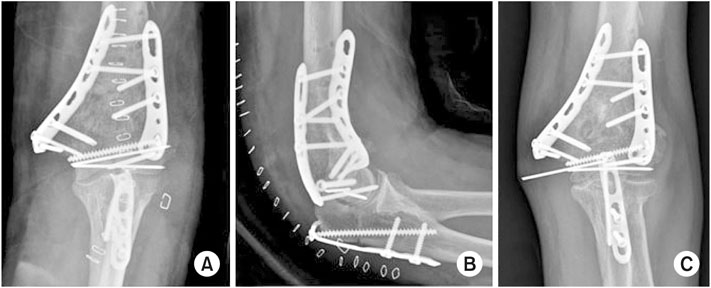J Korean Fract Soc.
2018 Apr;31(2):45-49. 10.12671/jkfs.2018.31.2.45.
How Difficult Is It to Surgically Treat AO-C Type Distal Humerus Fractures for Inexperienced Orthopedic Surgeons?
- Affiliations
-
- 1Department of Orthopedic Surgery, Daedong Hospital, Busan, Korea. redmaniak@naver.com
- KMID: 2409759
- DOI: http://doi.org/10.12671/jkfs.2018.31.2.45
Abstract
- PURPOSE
Twenty early surgical management cases of distal humerus type-C fractures were analyzed.
MATERIALS AND METHODS
This study analyzed 20 early patients, who received surgical management of distal humerus type-C fractures, and could be followed-ups for more than one year between March of 2013 and May of 2015. The operative time, bone union time, and elbow range of motion were analyzed. The Mayo's functional score was used to evaluate their postoperative function. The primary and secondary complications of each patient immediately after each of their surgery were also reviewed.
RESULTS
All patient groups achieved bone union within an average period of 16.4 weeks. Based on the Mayo functional score, 6, 10, and 4 patients scored excellent, good, and fair, respectively. The average range of motion was a flexion contracture of 14.5° with a follow-up improvement averaging 120.7°. Six patients received nine revision operations due to major and minor complications. Two patients received revision fixation from an inadequate fixating power, and another patient received an ulnar nerve transposition. Other complications included olecranon osteotomy site displacement, superficial operational site infection, and pin loosening.
CONCLUSION
Distal humerus fractures of the AO-C type can cause a range of complications and has a very high rate of revision due to its difficult nature of surgical manageability. Therefore, it is imperative for a surgeon to expect various complications beforehand and a careful approach to their postoperative rehabilitation is essential.
MeSH Terms
Figure
Reference
-
1. Eralp L, Kocaoglu M, Sar C, Atalar AC. Surgical treatment of distal intraarticular humeral fractures in adults. Int Orthop. 2001; 25:46–50.
Article2. Helfet DL, Hotchkiss RN. Internal fixation of the distal humerus: a biomechanical comparison of methods. J Orthop Trauma. 1990; 4:260–264.
Article3. Gupta R. Intercondylar fractures of the distal humerus in adults. Injury. 1996; 27:569–572.
Article4. Gupta R, Khanchandani P. Intercondylar fractures of the distal humerus in adults: a critical analysis of 55 cases. Injury. 2002; 33:511–515.
Article5. Jupiter JB, Neff U, Holzach P, Allgöwer M. Interchondylar fractures of the humerus. An operative approach. J Bone Joint Surg Am. 2001; 25:46–50.6. Yoon YC, Oh JK. Treatment of distal humeral fractures. J Korean Fract Soc. 2012; 25:223–232.
Article7. O'Driscoll SW. Parallel plate fixation of bicolumn distal humeral fractures. Instr Course Lect. 2009; 58:521–528.8. Jupiter JB, David R. Orthopaedic knowledge update shoulder and elbow. Philadelpia. AAOS:1997; 397–404.9. Aitken GK, Rorabeck CH. Distal humeral fractures in the adult. Clin Orthop Relat Res. 1986; 207:191–197.
Article10. Vazquez O, Rutgers M, Ring DC, Walsh M, Egol KA. Fate of the ulnar nerve after operative fixation of distal humerus fractures. J Orthop Trauma. 2010; 24:395–399.
Article11. Wang KC, Shih HN, Hsu KY, Shih CH. Intercondylar fractures of the distal humerus: routine anterior subcutaneous transposition of the ulnar nerve in a posterior operative approach. J Trauma. 1994; 36:770–773.12. Nauth A, McKee MD, Ristevski B, Hall J, Schemitsch EH. Distal humeral fractures in adults. J Bone Joint Surg Am. 2011; 93:686–700.
Article13. Cheon SJ, Lee DH, Goh TS. Double tension band osteosynthesis in intra-articular fractures of the distal humerus (AO type C) in elderly osteoporotic patients. Clin Shoulder Elbow. 2013; 16:33–39.
Article14. Riedel BB, Mildren ME, Jobe CM, Wongworawat MD, Phipatanakul WP. Evaluation of the learning curve for reverse shoulder arthroplasty. Orthopedics. 2010; DOI: 10.3928/01477447-20100225-09. [epub].
Article15. Kempton LB, Ankerson E, Wiater JM. A complication-based learning curve from 200 reverse shoulder arthroplasties. Clin Orthop Relat Res. 2011; 469:2496–2504.
Article16. Liu RW, Roocroft J, Bastrom T, Yaszay B. Surgeon learning curve for pediatric supracondylar humerus fractures. J Pediatr Orthop. 2011; 31:818–824.
Article
- Full Text Links
- Actions
-
Cited
- CITED
-
- Close
- Share
- Similar articles
-
- Ulnar Nerve Injury Caused by the Incomplete Insertion of a Screw Head after Internal Fixation with Dual Locking Plates in AO/OTA Type C2 Distal Humerus Fractures
- Operative Treatment of Three Part Fraetures of the Proximal Humerus Following AO/ASIF Principle
- Treatment of Comminuted Fracture of Distal Humerus in Adults
- Treatment for Comminuted fractures of Distal End of Humerus by Newly Developed Anatomical Plate: Three case report
- Double Tension Band Osteosynthesis in Intra-articular Fractures of the Distal Humerus (AO type C) in Elderly Osteoporotic Patients





